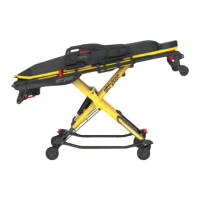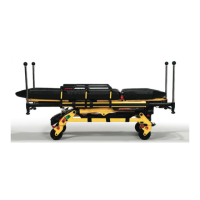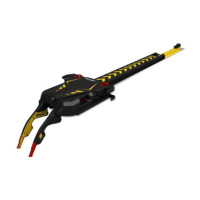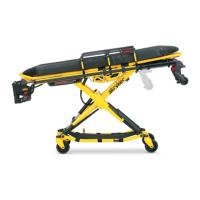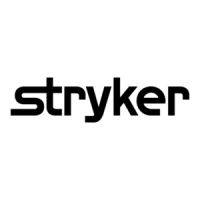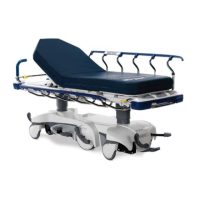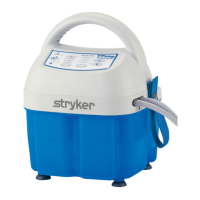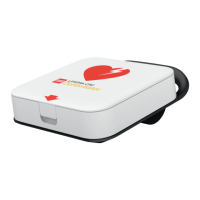• Always transport the cot at a lower height to reduce the risk of a cot tip. If possible, obtain additional assistance or take
an alternate route.
• Always avoid high obstacles, such as curbing, steps, or rough terrain to avoid the risk of the product tipping over.
• Always use PPoowweerr--LLOOAADD with the 6085/6086 PPeerrffoorrmmaannccee--PPRROO XT, 6500/6506 PPoowweerr--PPRROO XT, and 6510/6516
PPoowweerr--PPRROO IT cots with the PPoowweerr--LLOOAADD option only. In certain situations, you can use PPoowweerr--LLOOAADD as a standard
antler for most X-frame cots, but a rail clamp assembly is required for all cots without the PPoowweerr--LLOOAADD option.
• Always make sure that you use a PPoowweerr--LLOOAADD date of manufacture cot with the Stryker Model 6390 PPoowweerr--LLOOAADD
system to avoid the risk of injury.
• Always support the load of the patient, cot, and accessories after the weight is off of the ground.
• Two operators must be present when a cot is occupied.
• Do not load the cot into a vehicle with the head section retracted when using a cot fastener. The cot may tip or not
connect with the cot fastener.
• Always make sure that the safety bar connects with the vehicle safety hook before you remove the cot from the vehicle
patient compartment to avoid the risk of injury.
• Do not pull or lift on the cot safety bar when you unload the cot.
• Do not press the extend (+) button until the safety bar connects with the vehicle safety hook.
• Always lock the head section into place before you operate the cot.
• Do not install or apply a wheel lock on a product with worn wheels that are less than 6 in. diameter.
• Do not leave a patient or occupant unattended. Hold the product while a patient or occupant is on the product.
• Do not install these incubator adaptors on any other Stryker cot or on any cot from another manufacturer. These
incubator adaptors are for use only on the PPoowweerr--PPRROO IT cot.
• Always make sure that the incubator adaptor is properly installed on the cot and the incubator is securely fastened to the
incubator adaptor before use.
• Stryker is not responsible for specification changes to the DDrraaggeerr® (or AAiirr--SShhiieellddss® Series) incubators.
• Do not install the sled receptacle on any other Stryker cot or on any cot from another manufacturer. These sled
receptacles are for use only on the PPoowweerr--PPRROO IT cot.
• Stryker is not responsible for specification or option changes to airsled compatible incubators.
• Do not allow the head end storage flat (if equipped) to interfere with the operation of the retractable head section, safety
bar, or vehicle safety hook.
• Do not remove the battery when the cot is activated.
• Do not attempt to open the battery pack for any reason, to avoid the risk of electric shock. If the battery pack case is
cracked or damaged, do not insert it into the charger. Return damaged battery packs to a service center for recycling.
• Always avoid direct contact with a wet battery or battery enclosures. Contact may cause injury to the patient or operator.
• Do not insert a cracked or damaged SSMMRRTT Pak into the SSMMRRTT charger. Return damaged SSMMRRTT Paks to a service
center for recycling.
• Always have a certified mechanic, familiar with ambulance vehicle construction, install the optional mounting bracket
and the SSMMRRTT charger.
• Always mount the SSMMRRTT charger to the optional mounting bracket in an enclosed cabinet and out of patient reach
during transport to comply with established crash test standards.
• Always make sure that the optional mounting bracket is securely attached to the surface.
• Always use any appropriate personal protective equipment while power washing to avoid inhaling contagion. Power
washing equipment may aerate contamination.
• Always wipe the product with clean water and dry after cleaning. Some cleaning products are corrosive in nature and
may cause damage to the product. Failure to properly rinse and dry the product leaves a corrosive residue on the
surface of the product and may cause premature corrosion of critical components.
• Always wear insulated rubber gloves, in addition to personal protective equipment, when cleaning the SSMMRRTT Pak to
reduce the risk of injury.
• Always disconnect the SSMMRRTT charger from the wall outlet before cleaning to avoid the risk of electrical hazards.
• Do not spray fluid directly onto the SSMMRRTT charger.
• Do not power wash the SSMMRRTT charger.
• Do not use solvents, lubricants, or other chemicals to clean the SSMMRRTT charger unless otherwise directed.
• Do not immerse the SSMMRRTT charger in water or allow water to collect on top of the SSMMRRTT charger to avoid the risk of
electric shock.
• Always use only non-conductive materials to wipe the SSMMRRTT Pak.
EN 4 6516-209-001 Rev D.0

